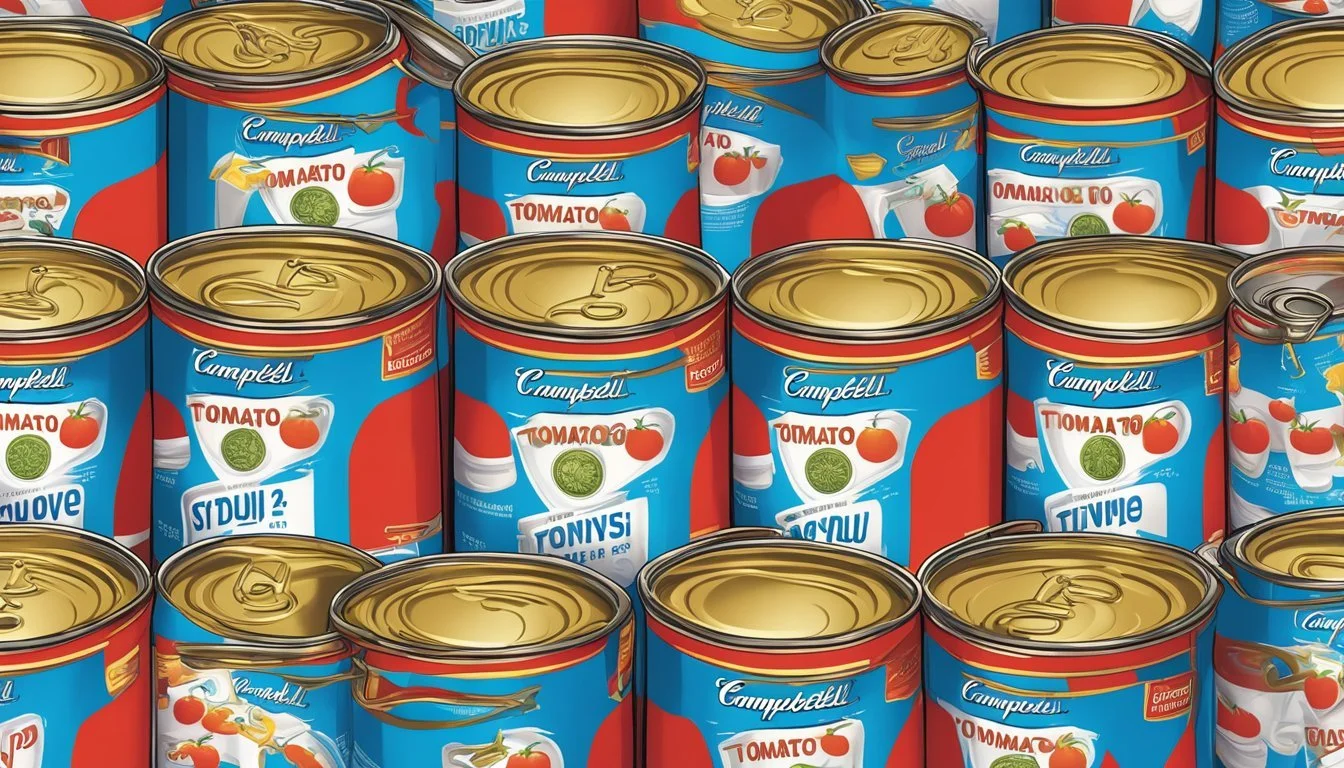How Many Cups of Campbell's Tomato Soup Per Day is Too Much?
Understanding Dietary Limits
Consuming Campbell's tomato soup can provide a comforting, nostalgic meal, especially when time is short or cooking from scratch is not an option. However, moderation is key when incorporating processed foods into a balanced diet. Campbell's condensed tomato soup contains a considerable amount of sodium—480 mg per half-cup serving—which is a significant factor to consider when determining how much to consume in a day. The American Heart Association recommends a daily sodium intake of no more than 1,500 mg to reduce the risk of high blood pressure and heart disease.
When it comes to nutritional content, a half-cup serving of Campbell's Tomato Soup contains 90 calories, negligible fat, and no cholesterol. The soup also provides 20 grams of carbohydrates per serving, which includes 12 grams of sugar. Given that the soup is relatively low in calories and contains no fat, the primary concern with overconsumption hinges on its sodium and sugar content. It is important to note that dietary needs vary among individuals, so the ideal amount of tomato soup will differ.
Individuals should always consider their overall dietary intake and health goals when incorporating any processed foods into their diet. While the convenience and taste of Campbell's tomato soup can make it an appealing option, it should be consumed in moderation as part of a varied and balanced diet. Transparency about serving sizes and understanding daily nutritional values play a crucial role in making informed dietary choices related to processed food products like canned soups.
Nutritional Profile of Campbell's Tomato Soup
The nutritional profile of Campbell's Tomato Soup reveals its calorie content, macronutrient distribution, and essential vitamins and minerals. This section breaks down these components to understand what one consumes when they enjoy a serving of this soup.
Calories and Fat Content
Calories: A serving size of ½ cup (120 ml) of Campbell's Tomato Soup provides approximately 90 calories.
Total Fat: The same serving contains negligible fat, with a reported 0% contribution from fat.
Sodium and Potassium Levels
Sodium: The sodium content is relatively high. A ½ cup serving holds a notable amount of sodium.
Potassium: Campbell's Tomato Soup also contains potassium, although in lesser quantities than sodium.
Sugar and Carbohydrate
Sugar: Each serving has added sugars contributing to its carbohydrate content.
Carbohydrate: A half-cup serving is primarily made up of carbohydrates, consisting mostly of sugars, accounting for 91% of its calorie composition.
Vitamins and Minerals
Campbell's Tomato Soup is reported to offer some vitamins and minerals that are essential for a healthy diet.
Vitamin C
Iron
Recommended Daily Intake
When considering how much Campbell's tomato soup to include in one's daily diet, it's essential to understand the concepts of Daily Value and assess the servings per container. These factors influence the overall nutritional intake and help maintain a balanced diet.
Understanding the Daily Value
The Daily Value (DV) is a guide that lets consumers know how much a nutrient in a serving of food contributes to their total daily diet. The DV is based on an average intake of 2,000 calories per day, although individual caloric needs may vary. For Campbell's tomato soup, the nutritional facts label provides key information regarding its contribution to the DV.
Campbell's Tomato Soup (per 1/2 cup serving):
Calories: 90
Total Fat: 0g (0% DV)
Sodium: 480mg
Given that the American Heart Association suggests a maximum sodium intake of 1,500 mg per day to minimize the risk of high blood pressure and heart disease, consumers should be mindful that one serving of Campbell's tomato soup contains a significant portion of the daily sodium limit.
Assessing Servings per Container
Another important aspect is the number of servings in each container of Campbell's tomato soup. A typical can contains about 2.5 servings, but family-size versions may contain more. By examining the label, one can determine the number of servings and make informed decisions on the quantity to consume in line with their daily dietary requirements.
Servings Information (regular can):
Servings Per Container: 2.5
Serving Size: 1/2 cup (120mL)
By taking into account both the serving size and the servings per container, individuals can calculate their intake of nutrients and adjust their consumption to avoid exceeding the recommended daily intake of various dietary components, particularly sodium.
Health Considerations
When considering how many cups of Campbell's tomato soup one can consume daily, it is crucial to evaluate its impact on heart disease, blood pressure, digestive health, and sugar intake.
Impact on Heart Disease and Blood Pressure
Campbell's tomato soup contains significant amounts of sodium, with a 1/2-cup serving supplying 480 mg. High sodium intake is linked to elevated blood pressure, and consistently high blood pressure increases the risk of heart disease. The American Heart Association recommends an intake limit of 1,500 mg of sodium per day, significantly less than the average American consumption.
Recommended Daily Sodium Intake:
Limit: 1,500 mg
Average Consumption: 3,436 mg
1/2-cup Campbell's Tomato Soup: 480 mg
Dietary Fiber and Digestive Health
Tomato soup can provide dietary fiber, which supports digestive health. However, the exact fiber content varies by recipe and product version. Consuming Campbell's tomato soup within a balanced diet that includes various fiber sources can aid digestion.
Dietary Fiber Content:
Varies: Check label for specific amounts
Managing Sugar Intake
A serving of Campbell's tomato soup may contain added sugars alongside naturally occurring ones. A 1/2-cup serving of Campbell's Tomato Soup has 12 grams of total sugars, some of which are added. The American Heart Association advises women to consume no more than 25 grams of added sugars per day and men no more than 36 grams.
Sugars Content:
Total Sugars in 1/2-cup: 12 g
Added Sugars: Check label for specific amounts
AHA Added Sugar Limit: Women 25 g / Men 36 g
Soup Ingredients Analysis
This section provides an in-depth look into the components that make up Campbell's tomato soup, focusing on its primary contents and the chemical additives that preserve its shelf life and enhance its flavor.
Key Ingredients in Tomato Soup
Campbell's tomato soup starts with tomato puree which is a blend of tomato paste and water, giving it the characteristic base flavor and texture. The thickening agent is wheat flour, and sugar is added to balance the tomato's natural acidity. Salt is a fundamental seasoning that brings out the soup's flavors. Moreover, ascorbic acid, commonly known as vitamin C, may be incorporated to maintain color and freshness.
Below is a summary of the main ingredients found in Campbell's tomato soup:
Tomato Puree (Water, Tomato Paste)
Wheat Flour
Sugar
Salt
Ascorbic Acid (potential ingredient for preserving color)
Common Additives and Preservatives
Preservatives and additives in Campbell's tomato soup include high fructose corn syrup (HFCS), a sweetener, and monopotassium phosphate, which serves as a preservative. Natural flavorings, like celery extract and garlic oil, might be included to enrich the soup's taste profile. While citric acid could serve as a preservative and flavor enhancer, ensuring the tanginess and freshness of the tomatoes.
A concise list of additives and preservatives that could be in the soup:
High Fructose Corn Syrup (Sweetener)
Monopotassium Phosphate (Preservative)
Natural Flavoring (Flavor enhancer)
Celery Extract (Flavoring component)
Garlic Oil (Flavoring component)
Citric Acid (Preservative and Flavor Enhancer)
Preparing Tomato Soup
When preparing Campbell's Tomato Soup, one can choose between the convenience of the canned condensed soup or creating a more personalized homemade version. Both methods offer a warm, comforting bowl, but differ in preparation and ingredients.
How to Make Campbell's Tomato Soup
To make Campbell's condensed tomato soup, one typically starts by emptying the contents of the can into a saucepan. Next, an equal can's measurement of water or milk is added, depending on the desired creaminess. This blend should be stirred thoroughly.
Steps:
Open the can and pour the condensed soup into the saucepan.
Add one can of water or milk.
Stir to combine.
The soup should be heated on the stove over medium heat while stirring occasionally until it is completely heated through. At this point, the soup is ready to be served, often accompanied by a classic grilled cheese sandwich or crackers.
Creating a Homemade Version
A homemade version of tomato soup allows for customization and may involve fresh ingredients like ripe tomatoes, aromatic vegetables, herbs, and spices. It begins with the preparation of a tomato base, typically achieved by simmering a mixture of tomatoes and water.
Ingredients:
Fresh tomatoes, diced
Water or vegetable stock for a richer flavor
Optional additions: onions, garlic, basil, salt, and pepper
The cook may choose to blend the tomatoes for a smooth consistency or leave them chunky according to preference, followed by adding the selected herbs and seasonings for flavor enhancement.
Preparation:
Combine tomatoes and water or stock in a large pot.
Cook over medium heat until tomatoes are soft.
Blend until smooth (if desired).
Season to taste and serve hot.
Homemade tomato soup can be a healthier option as one controls the ingredients, including the amount of salt, potentially making it a more suitable daily choice for those monitoring their sodium intake.
Comparison With Other Soups
When considering how many cups of Campbell's tomato soup one can have per day, it's important to look at how it compares nutritionally to other types of soups (What wine goes well with soups?), such as chicken and vegetable soups.
Tomato vs. Chicken Soup
Campbell's tomato soup is known for its rich tomato flavor and creamy texture. A key nutritional point of reference is its sodium content, which may be higher than that found in chicken soups. Chicken soup, often lauded for its healing properties, particularly during cold and flu season, can provide a valuable source of protein that is not as prevalent in tomato soup. This protein can be beneficial for muscle repair and immune system support.
When comparing Campbell's tomato soup to a typical chicken soup, one might find:
Protein: Chicken soup tends to contain more protein due to the presence of chicken meat.
Sodium: Both soups contain sodium, but tomato soup often has a higher amount which, if consumed in excess, may lead to increased blood pressure.
Tomato vs. Vegetable Soup
Vegetable soups often boast a variety of vegetables, making them rich in vitamins and minerals. Campbell's tomato soup, while containing tomato as a vegetable, might be limited in this broad-spectrum nutrient diversity. However, it typically offers a comforting, smooth consistency and a deep tomato flavor that some vegetable soups do not provide.
Nutritionally speaking, vegetable soups compared to Campbell's tomato soup may offer:
Fiber: A higher fiber content due to the variety of vegetables present.
Vitamins and Minerals: A richer array of vitamins and minerals from the inclusion of multiple vegetable types.
Campbell's tomato soup and various chicken and vegetable soups serve different dietary needs and preferences. While each has its own set of nutritional benefits, moderation is key in consumption to maintain a balanced diet.
Social and Cultural Impact
Campbell's Tomato Soup has not only been a dietary staple but also an emblematic symbol in various cultural domains. From its artistic representation to its inclusion in modern social platforms, it demonstrates a significant cultural footprint.
Campbell's Place in Popular Culture
Campbell's Soup Cans have transcended their status as just a food product to become a recognized icon in popular culture. Most notably, they were immortalized by artist Andy Warhol in 1962, when he chose Campbell's Tomato Soup as the subject for his famous work of art, thereby cementing its place in the annals of pop art history. The image of the familiar red and white can has come to represent American consumer culture, showcased in museums and galleries worldwide.
Sharing Recipes on Platforms like Pinterest
The rise of social media platforms such as Pinterest has facilitated the sharing of countless recipes, with Campbell's Tomato Soup often at the heart of these culinary exchanges. Pinterest users frequently post and share innovative recipes that repurpose Campbell's soup, showing how the product has been embedded in the collaborative culture of home cooking and digital recipe sharing. This online practice has broadened the soup's appeal, turning it into a versatile ingredient for new, creative dishes beyond the traditional soup bowl.
Consumer Guidance
When considering how many cups of Campbell's tomato soup one can consume daily, it is essential to understand the product's nutritional content and the legal considerations regarding its labeling and trademarks.
Understanding Product Labeling
The nutritional facts label on Campbell's tomato soup provides consumers with vital information about the ingredients and nutritional value. For instance, a 1/2-cup serving of the tomato soup contains 480 mg of sodium. The American Heart Association recommends an intake of no more than 1,500 mg of sodium per day to mitigate the risk of high blood pressure and heart disease. To decide on an appropriate daily consumption of soup, one must be aware of their overall dietary intake and how it aligns with daily nutritional guidelines.
Nutrition facts for Campbell's Tomato Soup (Per 1/2 Cup Serving):
Calories: 90
Total Fat: 0g
Sodium: 480mg
Total Carbs: 20g
Sugars: 12g (Includes 8g Added Sugars)
Protein: 2g
One should calculate their daily sodium and sugar intake, considering the 2,000 calories a day used for general nutrition advice, to ensure it does not exceed the recommended limits.
Copyright and Trademark Considerations
Campbell's Soup Company holds copyrights and trademarks related to their products. This includes distinctive package design, the company logo, product names, and the unique recipes used to create their soups. Consumers should respect these legal considerations, avoiding any unauthorized reproduction of the product branding or misrepresentation of the Campbell's brand. Whenever referencing the product, it's important to accurately cite the name and respect the company's intellectual property.










